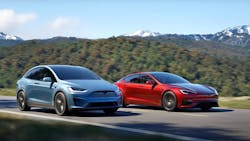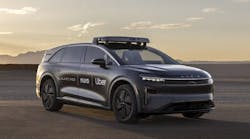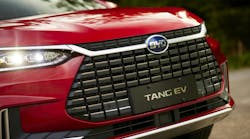Musk: End of EV Credits Could Mean ‘A Few Rough Quarters’ For Tesla
Tesla Inc.’s car business could be in for “a few rough quarters” because of the One Big Beautiful Bill Act’s provision eliminating federal tax credits for electric vehicles on Sept. 30, CEO Elon Musk said July 23. The EV market leader’s executives also declined to provide guidance for the rest of 2025, said that tariffs will cost the company about $300 million this year and noted that the company last month built the first models of a long-promised more affordable model.
“We’re in this weird transition period where we will lose a lot of incentives,” Musk said during a conference call discussing the company’s second-quarter results. “Does that mean we could have a few rough quarters? Yes, we probably could have a few rough quarters. And I’m not saying we will, but we could [in] Q4, Q1, maybe Q2.”
Musk issued his warning about the effects of the $7,500 tax credits’ expiration—which doesn’t bode well for the prospects of other EV manufacturers without the financial muscle of Tesla—after a quarter in which Tesla’s car business shrunk by double digits compared to last year. Overall, the company produced a net profit of nearly $1.2 billion on total revenues of $22.5 billion. Those figures were down 16% and 12%, respectively, from the same period of 2024.
But automotive revenues fell 16% to $16.7 billion in the three months that ended June 30 as Tesla delivered about 384,000 cars, a drop of 13% from the prior-year quarter. Changes in mix also lowered the company’s average selling price for the quarter, which contributed to free cash flow being $146 million last quarter compared to $664 million early this year and more than $1.3 billion in Q2 of 2024.
The OBBBA will make it harder for Tesla to reverse that trend because it also cuts emissions standards penalties and will thus lower Tesla’s sales of regulatory credits, CFO Vaibhav Taneja said on the earnings call. Tesla sold $439 million in tax credits in the second quarter.
Taneja also said the company has a limited supply of vehicles to sell ahead by Sept. 30 and “may not be able to guarantee delivery orders placed in the later part of August and beyond.”
Losing EV credits also has pushed back Tesla’s schedule to ramp up production of its lower-cost model. Taneja said the company is focused on building and delivering as many cars as possible over the next 70-odd days that increasing production of the more affordable car has become a fourth-quarter event.
In not providing guidance for the rest of 2025—something they said three months ago they would—Tesla leaders pointed to the by-now usual suspects.
“It is difficult to measure the impacts of shifting global trade and fiscal policies on the automotive and energy supply chains, our cost structure and demand for durable goods and related services,” they said in their report. “While we are making prudent investments that will set up both our vehicle and energy businesses for growth, the actual results will depend on a variety of factors, including the broader macroeconomic environment, the rate of acceleration of our autonomy efforts and production ramp at our factories.”
During the call, Musk and his lieutenants sought to again emphasize the company’s ambitions in robotics—“Autonomy is the story,” Musk said—and said they’re looking to apply the same artificial intelligence training techniques to their Optimus robots as it has to autonomous driving. Musk said he expects Tesla to be producing prototypes of the third version of Optimus by late this year before starting production at scale in 2026 and rapidly building from there.
“If we are not roughly making 100,000 Optimus robots a month in 60 months, I would be shocked,” he said.
Shares of Tesla (Ticker: TSLA) fell more than 4% to about $318 in after-hours trading July 23 and slumped more the next morning: Around 10 Eastern, they were down more than 7% to $308. Over the past six months, they have lost more 20% of their value, which has cut the company’s market capitalization to about $990 billion.
About the Author
Geert De Lombaerde
Senior Editor
A native of Belgium, Geert De Lombaerde has been in business journalism since the mid-1990s and writes about public companies, markets and economic trends for Endeavor Business Media publications, focusing on IndustryWeek, FleetOwner, Oil & Gas Journal, T&D World and Healthcare Innovation. He also curates the twice-monthly Market Moves Strategy newsletter that showcases Endeavor stories on strategy, leadership and investment and contributes to other Market Moves newsletters.
With a degree in journalism from the University of Missouri, he began his reporting career at the Business Courier in Cincinnati in 1997, initially covering retail and the courts before shifting to banking, insurance and investing. He later was managing editor and editor of the Nashville Business Journal before being named editor of the Nashville Post in early 2008. He led a team that helped grow the Post's online traffic more than fivefold before joining Endeavor in September 2021.



